Elderberry in a New Perspective: Between the Analyst and the Pharmacist – Current Conclusions Based on the Smart Supplement Monitor. This report is an example of reasoning for the exploration field of a selected ingredient on many levels. The analysis of a specific manufacturer is not an advertisement. It is an objective way of looking at trends, rankings and comparisons. Most charts present data for the period from January, 2020 to August, 2023, with exceptions which clearly result from the presented chart or narrative.
Briefly about the plant
Elderberry is a shrub which provides two main pharmaceutical raw materials: flowers and fruit. This plant has a long history of use in folk medicine to treat colds and flu. It is also traditionally used as a laxative, diuretic and diaphoretic, as well as an immune system stimulator. Polyphenols contained in elderberry may be responsible for its antioxidant effects.
The use of elderberry is considered to be safe. If side effects occur, they are probably caused by eating raw and unripe elderberries or seeds, leaves and other plant parts. Due to cyanogenic glycosides, they may cause severe diarrhea, nausea, vomiting, the feeling of weakness and dizziness. Thermal treatment (cooking) eliminates the toxin.
Elderberry preparations may interact with immunosuppressive drugs due to their potential immunomodulatory effect (e.g. azathioprine or cyclosporine). Patients with autoimmune diseases should be advised against taking elderberry, as it may exacerbate the course of disease by increasing the production of cytokines, including interleukin.
Latest submissions and elderberry
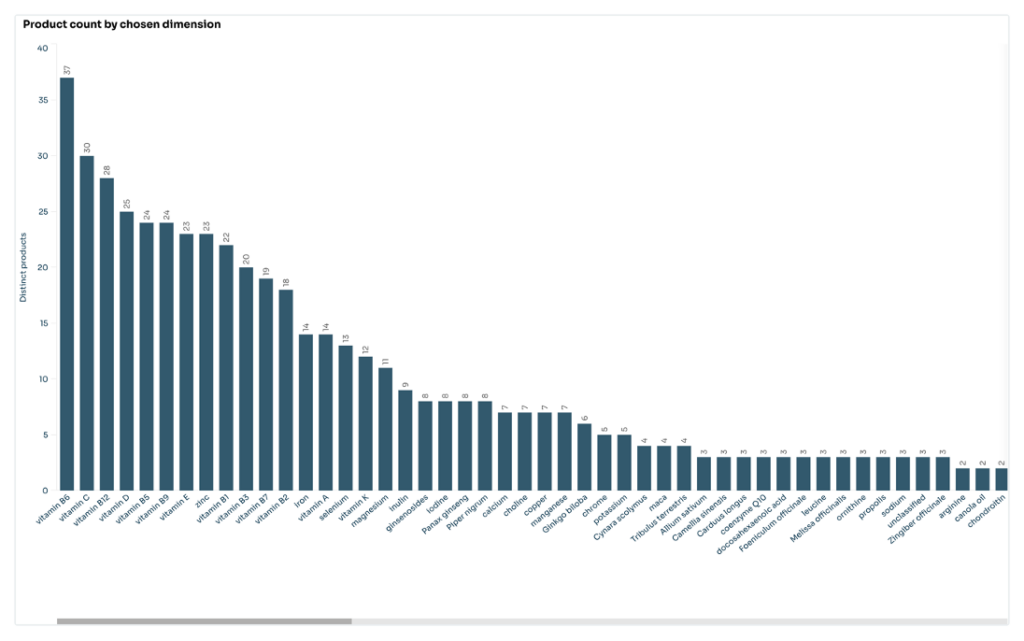
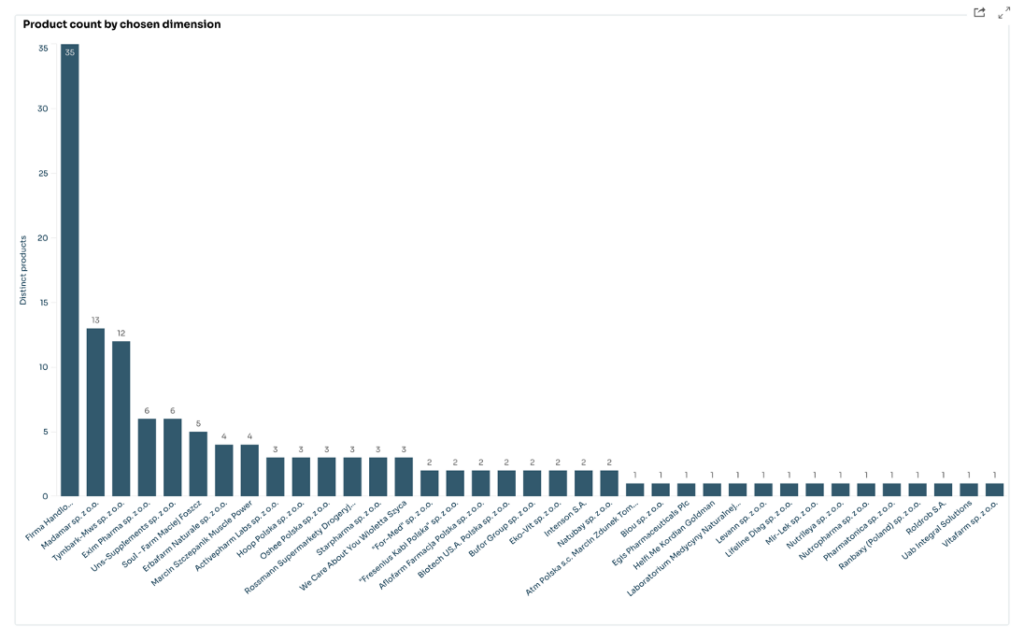
Notifications for the last 7 days (as of August 29, 2023)
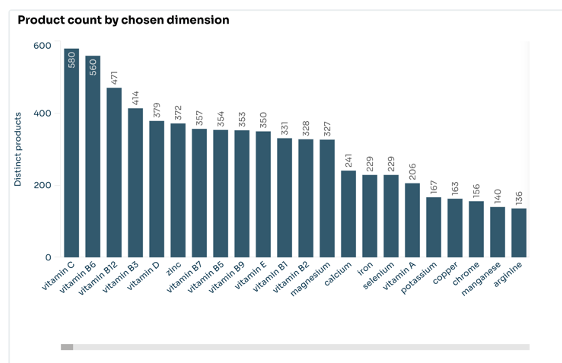
Notifications for the last 90 days (as of August 29, 2023)
- From the analyst’s perspective: Looking at the number of reports from the last 7 and 90 days, the ingredients are still dominated by preparations with vitamin C and B vitamins, but the popular vitamin D and zinc are also visible. Therefore, we observe the presence of ingredients found in preparations used in the upcoming infection season. The manufacturer with over 200 notifications is interesting… What is the place of elderberry on this list?
- From the pharmacist’s perspective: Conducted research confirms the effectiveness of elderberry when used to relieve flu symptoms and as an addition to mouthwashes to reduce gum inflammation. I emphasize the word reduction – that is it will not work as a preventive measure, but during an infection, when the first symptoms of flu or cold begin to appear.
Plant popularity based on the Smart Supplement Monitor
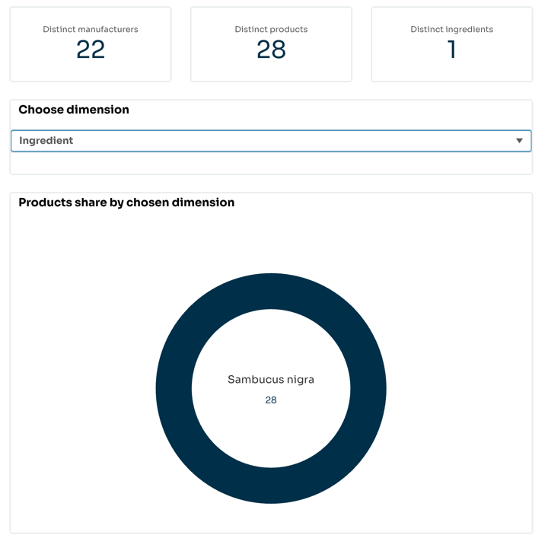
Notifications for the last 90 days (as of August 29, 2023)
- From the analyst’s perspective: Elderberry spotted. Over the last 90 days, 28 unique products by 22 manufacturers have been submitted to the GIS register. It is almost the same amount as in the analogous period a year ago. In the last week there was only one preparation. Comparing the popularity of elderberry to vitamin C, we are talking about the ingredient being more than 20 times less popular. Well, the use of vitamin C is extremely versatile (or that is a case of claims ;)). Is not vitamin C also an active ingredient contained in elderberry?
- From the pharmacist’s perspective: Yes, an elderberry fruit is a valuable source of vitamin C. 100 grammes of raw material contains as much as 80 mg of this vitamin. Let me remind you that for healthy adults, the daily requirement for vitamin C is 1 mg/kg of body weight. Moreover, ripe fruit is a valuable source of anthocyanidins, which have immunomodulatory and anti-inflammatory effects. They also contain flavonoids: rutin and quercetin. Its flowers also contain chlorogenic acid, which has antibacterial and anti-inflammatory properties, as well as magnesium, iron and zinc.
Elderberry – basic statistics
- From the analyst’s perspective: From the beginning of 2020 until today, 557 notifications have been recorded in the GIS register. The predominant registration qualification is a dietary supplement status. The most popular product forms are capsules, liquids and tablets. We also have sweets, but these are single occurrences. The leaders among the reporting entities are Polski Lek and the distributor – Olivit. These entities reported 20 preparations containing elderberry each. Just wondering what type of ingredient combinations dominated in these preparations… But before that, let’s take a look at the line charts and trend analysis.
- From the pharmacist’s perspective: Both flowers and fruit, apart from medicinal purposes, are also used to produce weak alcoholic beverages. The fruit is widely used as a natural food colouring agent.
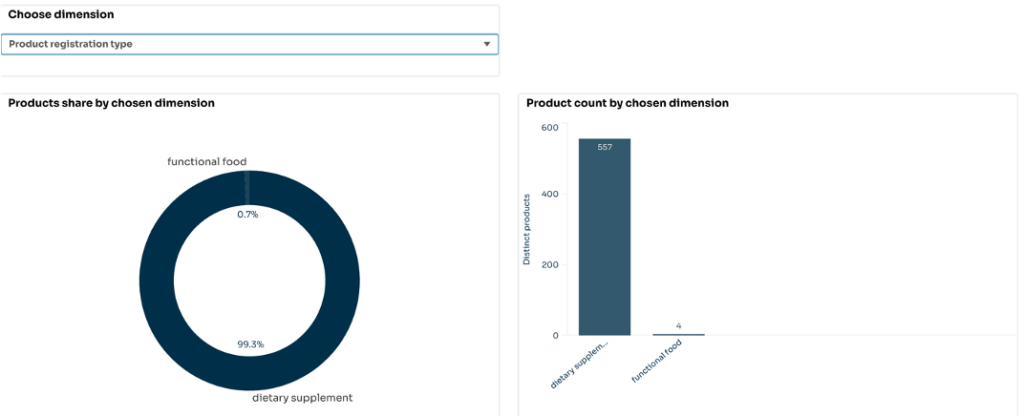
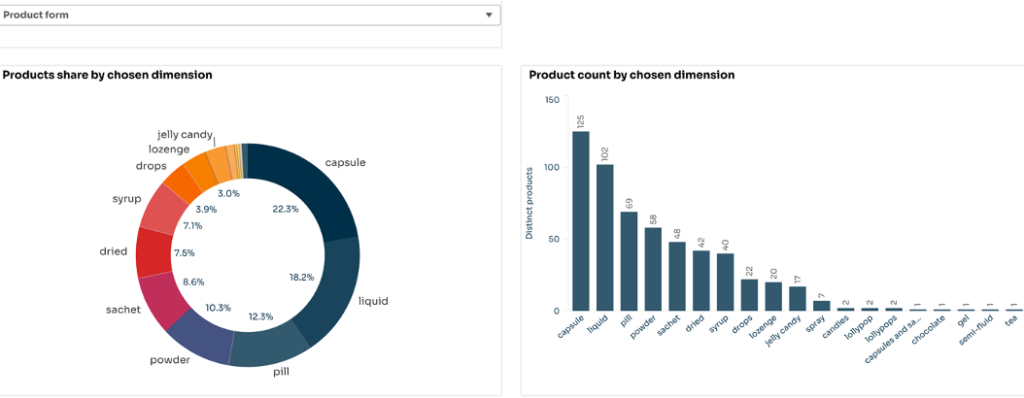
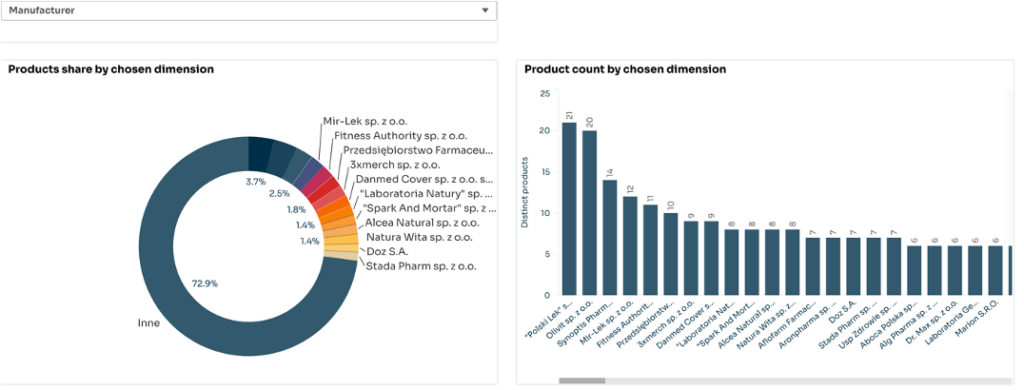
Notifications from January 2020 (as of August 29, 2023)
Elderberry from a long-term perspective
- From the analyst’s perspective: Elderberry in retrospect. The boom related to dietary supplements and the pandemic situation also affected elderberry. In some quarters, the increases in notifications for preparations with this plant are impressive. However, there is a clear break in the trend, related to the “extinguishing” of the pandemic and the return to the “new normal”. At the moment, I do not see any major changes in the development trend.
- From the pharmacist’s perspective: Despite the claims, there is no reliable evidence to support the use of elderberry in the treatment of COVID-19. Instead, it is worth promoting a healthy lifestyle and proven methods of prevention.
Due to the multitude of health-promoting ingredients, elderberry may potentially support the treatment of diseases such as:
- hyperlipidemia,
- lower respiratory tract infections,
- sinusitis,
- obesity.
Therefore, this plant is a constant subject of scientific research. However, at the moment there is no reliable data assessing the aforementioned properties and it is unclear whether such an effect is observed when elderberry is used alone or in combination with other ingredients.
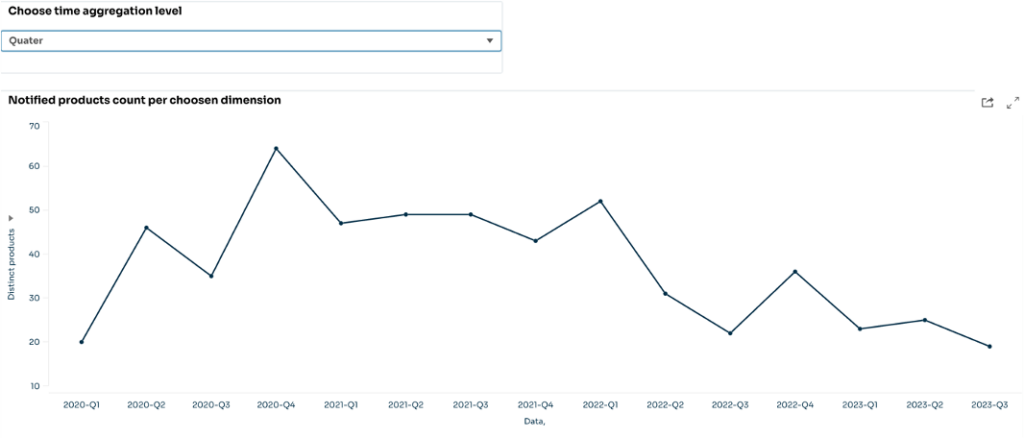
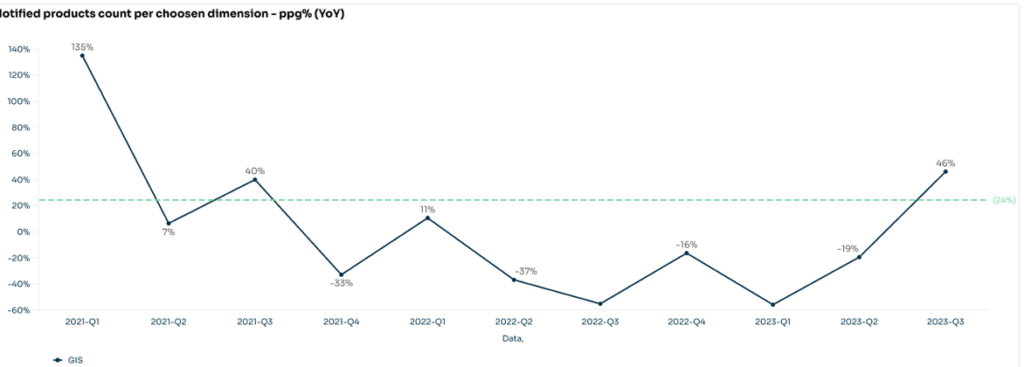
Elderberry and its company
- From the analyst’s perspective: This raw material appeared together with over 400 ingredients, mainly among other plant ingredients, vitamins and minerals. Looking at the probability vector of ingredient occurrence, it can be concluded that this raw material is popular as a monopreparation, and if it occurs in complex products, it mainly contains vitamin C (40% of preparations), vitamin D (21% of preparations) and zinc (38% of preparations), which makes sense considering its intended use.
- From the pharmacist’s perspective: These are common combinations in dietary supplements available on the market. The packaging and leaflet often read: “A dietary supplement with a beneficial effect on the upper respiratory tract and supporting the functioning of the immune system.” However, it is worth keeping in mind the proven properties of these three ingredients and taking into account what infections we are dealing with (flu or cold), as well as choosing the appropriate dose or form of the product.
Zinc — necessary for the proper functioning of the immune system. Its deficiencies may increase susceptibility to infections. When it comes to the treatment of infections, further research is needed to select the appropriate dose. Products available on the market have a too low dose of zinc to achieve therapeutic effects.
Vitamin D – has immunomodulatory effects and improves the differentiation of immune cells.
Vitamin C — clinical studies have shown that daily vitamin C supplementation in doses above 200 mg/day did not reduce the risk of developing the common cold. The exception were clinical tests involving several hundred professional athletes. Supplementation with the indicated dose of vitamin C may shorten the duration of the disease by approximately 1 day. Higher doses (even 2000 mg!!), contrary to prevailing beliefs and myths, do not intensify this effect and may even cause side effects, mainly from the digestive system.
However, it should be added here that not every plant raw material has research confirming its effectiveness. The use of some plants is based on traditional use. This does not mean that a given product may not produce the expected effect, but that scientific data in this area is unknown. Long-term use may also indicate potential effectiveness.
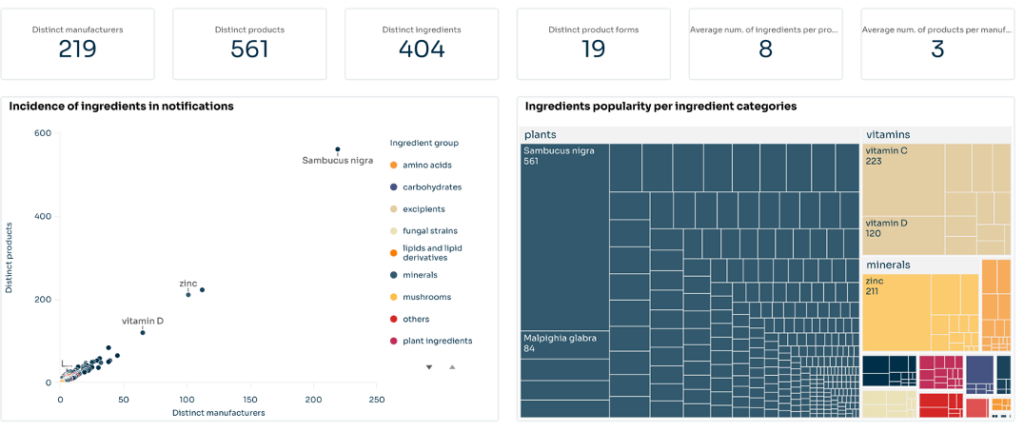

Notifications from January 2020 (as of August 29, 2023)
General pattern and an individual approach
- From the analyst’s perspective: This is a good moment to return to Polski Lek for a moment. Are there any differences in the composition of this manufacturer’s compositions compared to the general standard? There is definitely a smaller range of ingredients (28). A change in the likelihood of occurrence of the “big three” ingredients associated with elderberry can be easily noticed. Vitamin C and zinc appear together in virtually every composition. Vitamin D, selenium, rutoside, but also B vitamins are added quite often. Looking at the detailed decomposition of the compositions, it is puzzling whether the combination of elderberry, great mullein, purple coneflower, common verbena as ingredients from the plant category, and minerals such as zinc, selenium, as well as vitamin C and rutoside, really gives a “boost” in synergistic action? Or maybe the risk of antagonisms between so many components at once is increasing?
- From the pharmacist’s perspective: In products containing several, a dozen or even several dozen (!!) ingredients, there is a risk of composing the composition in such a way that a negative relationship, i.e. an antagonism, may occur. Therefore, the soon-to-be-available Smart Supplement tool will be extremely helpful for detecting undesirable combinations in order to avoid, for example, the phenomenon when one ingredient weakens the effect of another ingredient.
Returning to less common combinations – vitamin B6 and vitamin B12 support immunity at the cellular level. The composition with other plant raw materials: gentian root, primrose flower, sorrel herb and verbena herb is a combination known from a popular medicinal product used in acute and chronic sinusitis in the form of coated tablets and drops.
The combination of elderberry in an extract composed of coltsfoot leaf, linden flower and willow bark is a well-known mixture in an OTC medicine traditionally used in a low fever.
The use of echinacea and elderberry preparations may affect the concentration of drugs metabolized by CYP3A4, e.g. fluoxetine, calcium channel blockers (e.g. diltiazem), antifungal drugs (e.g. itraconazole), omeprazole, clarithromycin or ciprofloxacin. However, this is due to the content of echinacea and not elderberry. Patients using these products simultaneously should exercise extreme caution as treatment failure may occur.

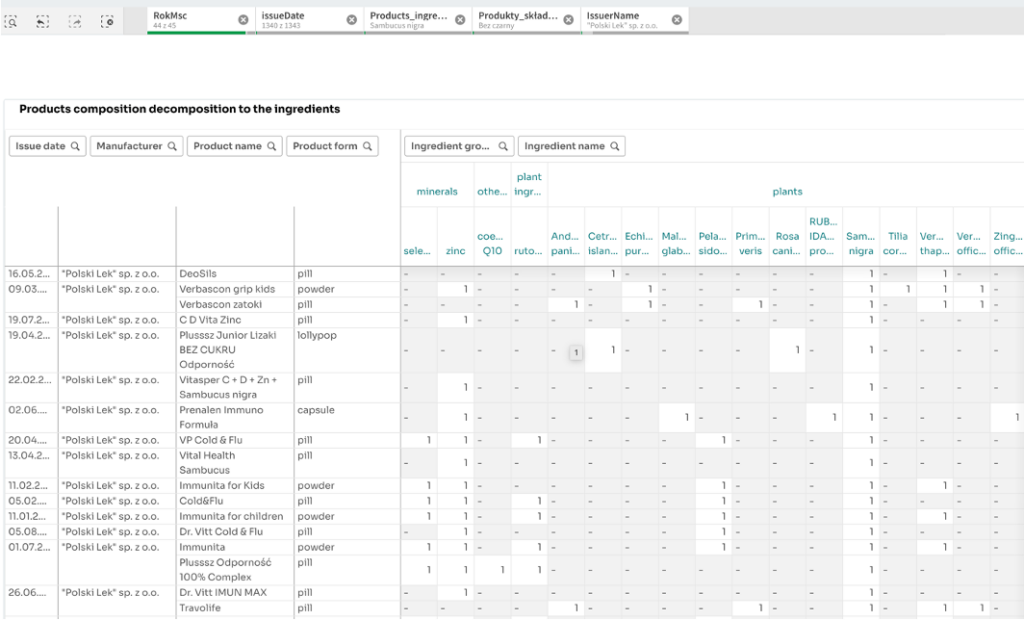
Notifications from January 2020 (as of August 29, 2023)
We shift into a high gear – ingredient compositions from a machine learning perspective
- From the analyst’s perspective: Although it is not helpful to look at product compositions in the classic frequency approach, or let’s call it the “helicopter view” approach, the culmination of pattern analysis is grouping (clustering of products) into specific composition patterns and then presenting them in terms of popularity ranking understood as the number of products.
To work! Our collection includes 528 products with elderberry. 457 of them show a certain similarity to its neighbour. Preparations similar to “anything” were grouped into 12 clusters, differing in number and pattern, or more precisely in the centroid. Belonging to a given cluster in practice means that this group of products is in a sense homogeneous and differs in some way from preparations in other clusters. 71 – is the number of deviating observations, which means that these preparations do not match any identified pattern which occurs in the centroid of each cluster. Among them, you can look for inspirations for compositions unlike any other (unique or random).
Analyzing the structure of the first 3 clusters, we see that the “centroid” (green) in each of them consists of elderberry, zinc and vitamin C. The term core means that these ingredients always appear in every cluster preparation. However, we may encounter other ingredients around the centroid.
For example, cluster number 2 consists of 115 products, which constitutes over almost 20% of all preparations with elderberry. How to look for differences in compositions in a similar group of products and assess whether they are attractive from the consumer’s point of view? Just look at the detailed summary (table) and look for inspiration there. At first glance, the combination with beta-glucan and vitamin B seems interesting. Is this an “eureka moment” in terms of benefits for the patient?
- From the pharmacist’s perspective: Beta-glucans are part of dietary supplements recommended mainly to strengthen immunity. However, the immunostimulating effect has not been clinically proven. This ingredient potentially fights respiratory infections that are caused by physical exercise
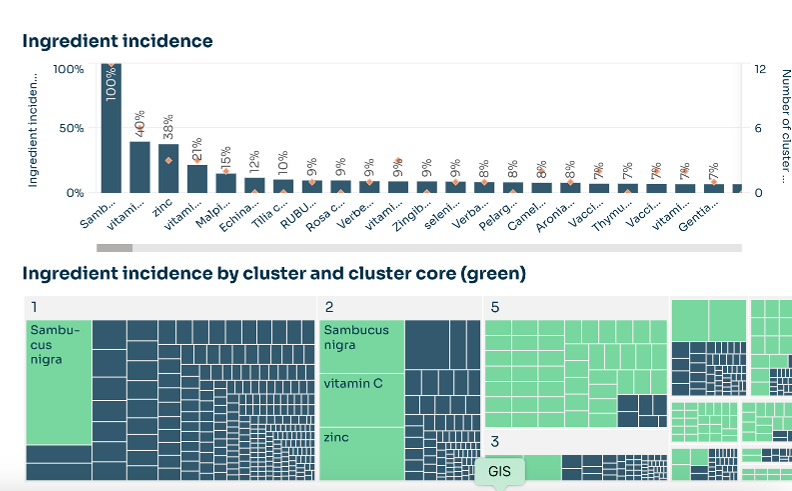
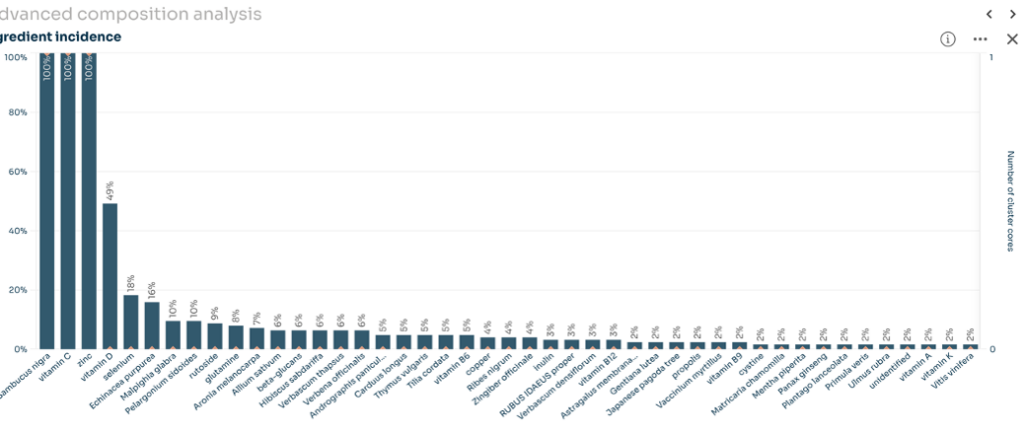
Notifications from January 2020 (as of August 29, 2023)
Universal strategies
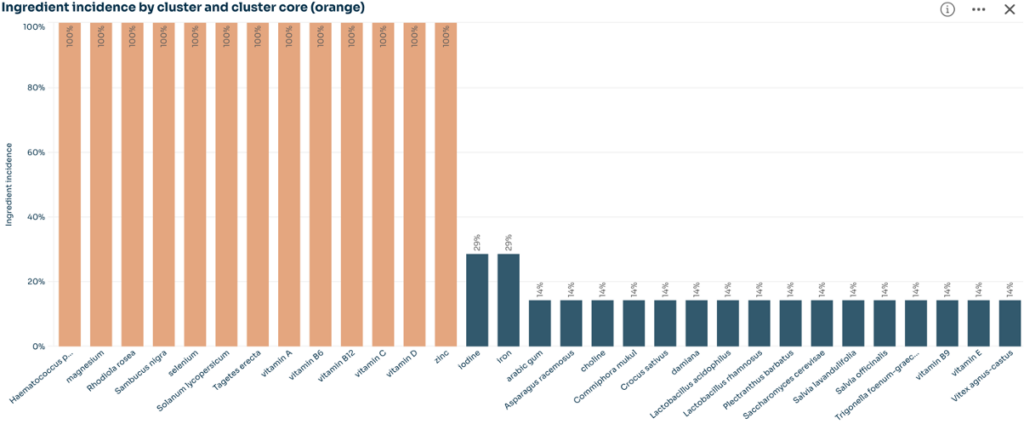
Notifications from January 2020 (as of August 29, 2023)
- From the analyst’s perspective: An interesting cluster with 7 products of the same brand. Rich “centroid”, with as many as 13 ingredients. Basically, there are no differences between the products at the composition level… But what a wide range of applications, considering the names of the preparations? Does this make sense?
- From the pharmacist’s perspective: All products were submitted at the same time, so we are not dealing here with the popular marketing phenomenon of “umbrella branding”, i.e. the emergence of other products from the portfolio on one proven leader. The first product which caught my eye was “WIMIN Zestaw z myślą o dziecku”, which has nothing to do with the PTGIN guidelines. Where are DHA acids, where is vitamin D? Such a name may mislead the patient. Of course, each of us has the opportunity to check what we are buying, to read the composition and talk to a pharmacist
BIBLIOGRAFIA:
- Kong F. Pilot clinical study on a proprietary elderberry extract: efficacy in addressing influenza symptoms. Online Journal of Pharmacology and Pharmacokinetics 2009;5:32-43.
- Kunitz S, Melton RJ, Updyke T, et al. Poisoning from elderberry juice. MMWR 1984;33:173-4.
- Barak V, Halperin T, Kalickman I. The effect of Sambucol, a black elderberry-based, natural product, on the production of human cytokines: I. Inflammatory cytokines. Eur Cytokine Netw 2001;12:290-6.
- Vlachojannis JE, Cameron M, Chrubasik S. A systematic review on the sambuci fructus effect and efficacy profiles. Phytother Res. 2010 Jan;24(1):1-8.
- Tiralongo, E., Wee, S. S., Lea, R. A. (2016). Elderberry Supplementation Reduces Cold Duration and Symptoms in Air-Travellers: A Randomized, Double-Blind Placebo-Controlled Clinical Trial. Nutrients, 8(4), 182.
- Murkovic, M., Abuja, P. M., Bergmann, A. R., Zirngast, A., Adam, U., Winklhofer-Roob, B. M., Toplak, H. (2004). Effects of elderberry juice on fasting and postprandial serum lipids and low-density lipoprotein oxidation in healthy volunteers: a randomized, double-blind, placebo-controlled study. European journal of clinical nutrition, 58(2), 244–249.
- Rusińska A, Płudowski P, Walczak M, Borszewska-Kornacka MK, Bossowski A, Chlebna-Sokół D, Czech-Kowalska J, Dobrzańska A, Franek E, Helwich E, Jackowska T, Kalina MK, Konstantynowicz J, Książyk J, Lewiński A,
- Łukaszkiewicz J, Marcinowska-Suchowierska E, Mazur A, Michałus I, Peregud-Pogorzelski J, Romanowska H, Ruchała M, Socha P, Szalecki M, Wielgoś M, Zwolińska D, Zygmunt A. Vitamin D Supplementation Guidelines for General Population and Groups at Risk of Vitamin D Deficiency in Poland—Recommendations of the Polish Society of Pediatric Endocrinology and Diabetes and the Expert Panel With Participation of National Specialist Consultants and Representatives of Scientific Societies—2018 Update. Front Endocrinol (Lausanne).
- Maywald, M., Wessels, I., Rink, L. (2017).:Zinc Signals and Immunity. International journal of molecular sciences, 18(10), 2222
- Fazilaty, Z., Chenari, H., Shariatpanahi, Z. V. (2018). Effect of ß-glucan on serum levels of IL-12, hs-CRP, and clinical outcomes in multiple-trauma patients: a prospective randomized study. Ulusal travma ve acil cerrahi dergisi Turkish journal of trauma & emergency surgery : TJTES, 24(4), 287–293.
- Mosikanon, K., Arthan, D., Kettawan, A., Tungtrongchitr, R., Prangthip, P. (2017). Yeast β-Glucan Modulates Inflammation and Waist Circumference in Overweight and Obese Subjects. Journal of dietary supplements, 14(2), 173–185.
- Hemilä, H., Chalker, E. (2013). Vitamin C for preventing and treating the common cold. The Cochrane database of systematic reviews, (1), CD000980.

 Polski
Polski
